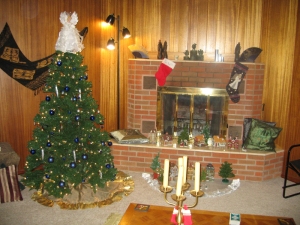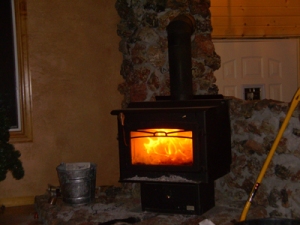Reflections on Moving to North Dakota in the Winter
 Recently, FHS member Joseph Jones moved from the forested land of Michigan to the treeless wonderland that is western North Dakota. We here at the Peeling Back the Bark HQ were fascinated by his description of a culture that values fireplaces where there is no apparent local supply of wood and asked him to share his thoughts on the matter.
Recently, FHS member Joseph Jones moved from the forested land of Michigan to the treeless wonderland that is western North Dakota. We here at the Peeling Back the Bark HQ were fascinated by his description of a culture that values fireplaces where there is no apparent local supply of wood and asked him to share his thoughts on the matter.Life for newly-minted Ph.D.s is hard these days. Jobs are scarce and family members don’t understand how someone with so much education can have such a hard time finding a job to pay the bills. After all, doesn’t a scholar sit around all day in a tweed jacket smoking a pipe and expounding on philosophical observations that no one else not attired in tweed cares about? Being in my last year as a visiting assistant professor at Grand Valley State University in Allendale, Michigan, made me acutely aware of the disconnect between the popular image and the harsh reality for scholars on the job market.
Needless to say, given the conditions, I was thrilled to land the position of research historian for the Theodore Roosevelt Center at Dickinson State University in Dickinson, North Dakota. The Center has launched an initiative to digitize and catalog the entire collection of Theodore Roosevelt papers into an online digital library. I am responsible for doing research and writing, providing historical context, and making educational contacts for the Center.

Theodore Roosevelt Center staff on retreat at Theodore Roosevelt National Park. (l-r) Park Superintendent Valerie Naylor, Krystal Thomas, Sharon Kilzer, Grant Carlson, Joe Camisa, and Joseph Jones. (Courtesy of Clay Jenkinson)
Amidst the excitement of a new job was the challenge of relocating from Michigan to North Dakota in January with a four-month old and a cat. My wife squeezed her mother and our baby Rose into her car, while I loaded Dorie the cat into mine for the three-day drive in single-digit conditions. For a forest historian, there were many topics to discuss with Dorie. I bade goodbye to the familiar forests that line I-196 south of Holland (Mich.). I pondered urban forestry with numerous glimpses of the Cook County Forest Preserve (Ill.). I mused on when I’d have a chance to wander the grounds at the Aldo Leopold Legacy Center when entering Sauk County (Wisc.). Along I-94 northwest of Saint Cloud (Minn.), I skirted the edge of the prairie on my left with recreational lakes and forests to the right.
Yet all of these sites were familiar to me, a native of the Great Lakes region. Even though I had never been to western Minnesota, it felt familiar. The forest surrounding a rest area near Fergus Falls was a point of comfort despite temps colder than those usually found in northern Michigan. But the change was abrupt once we crossed the Red River into North Dakota. The contours of the land flattened and the forests vanished. The wide prairie opened before me and I learned that “wind-swept” is not just a literary adjective. Yet, what stood out on the eastern North Dakota landscape were the shelterbelts. The philosophical rise and fall of shelterbelts as an ecological and political concept were visible in their current condition. While the vertical and spatial arrangements envisioned by Raphael Zon were there, he would have been sorely disappointed in their maintenance. They appeared neglected and overgrown. The old growth was collapsing in on itself, while death had opened sections of the belts to open air. I am sure that Zon, America’s leading experiment station researcher in the first half of the twentieth century, would have wanted to investigate where his proposal had gone wrong and if the project was worth rehabilitation.

White Butte (highest point in North Dakota) near Amidon. Note the shelterbelts on the right side of the photo. Such mature trees are a good example of existing standing wood sources away from houses in southwestern North Dakota. (Courtesy of Keri Youngstrand)
Once we crossed the Missouri River in Bismarck, the landscape changed. The rolling hills and hard character suggested that the Badlands were on the horizon. The shelterbelts became less frequent and the few trees were often nestled around the sparse ranch homes off the interstate. Dickinson sprawled like a mirage at the crest of one such hill a hundred miles west of the capitol. Dorie and I, as well as our companions, had made the journey without incident.
After settling into our rented townhouse, we took advantage of the unseasonably warm weather—temps in the 40s—to start house hunting. The oil boom in western North Dakota had significantly driven up housing prices in the last few years, yet we found several affordable ranch and split-level homes. The interesting feature, though, were the wood stoves and fireplaces. Nearly every home we viewed had at least one of these that had been recently used. At first, I thought it was a joke or a misplaced artifact in a land with so few trees. I commented on it to our real estate agent, but she seemed nonplussed by the observation. Being a life-long resident, she considered the fireplaces normal.

A southwestern North Dakota fireplace at the holidays (Courtesy of Michelle Stevier)
The second week we were in town, the weather turned colder with strong winds. This blizzard changed my perspective on the wood stoves. Power outages were widespread and wind chills were 30 degrees below zero. Forced air furnaces were worthless without electricity and the cold was a real threat. I realized that wood stoves were the ubiquitous Plan-B in southwestern North Dakota. Fireplaces were not an interior decoration, but a means for survival when the infrastructure failed.
This realization gave meaning to the wood stoves and fireplaces, but the source of the wood was still in doubt. Much of it likely comes from the remnants of storm damage to the trees in town. Some people likely have access to shelterbelts or small woodlots on family farms. Keri Youngstrand, the owner of the stove in the photograph, stated that some people use old cedar fence posts. But that amount of wood does not seem sufficient to address the demand. Fireplace owner Michelle Stevier recounted having firewood stolen when she and her husband removed dead trees on their property. I have heard rumors of a smuggling operation from Montana. Ann Robbins, a Wisconsin transplant, suggested that maybe it all came from a wood fairy. The source of the wood remains a mystery.
The lack of wood also begs the question about why North Dakota has not seen a wholesale conversion to pellet stoves and other alternative sources of heat. Many such units can function without electricity and do not use wood as their fuel. I did not see any such units in my home visits. My investigation continues.

An action shot of a southwestern North Dakota wood stove (Courtesy of Keri Youngstrand)
These conversations surrounding firewood have given me a unique insight into life and culture in North Dakota. During the last week many locals have been discussing the national story about a family that is abandoning small town life in Hazelton despite the many enticements they were given to come. There has even been a suggestion that new residents should take an orientation course. My orientation has not followed the devised curriculum. It has focused on numerous discussions with locals and transplants alike about the trees or the lack thereof in the Northern Great Plains.
On a happy note, we have found a home to buy. By this spring, I will be the proud owner of a home with two fireplaces!

One of my new fireplaces! (Courtesy of Cheryl Jones)

